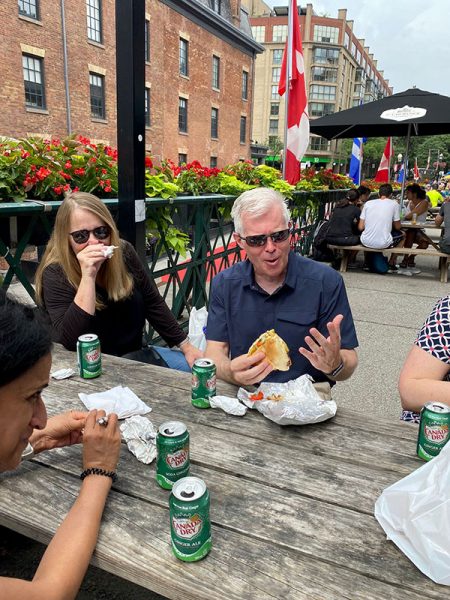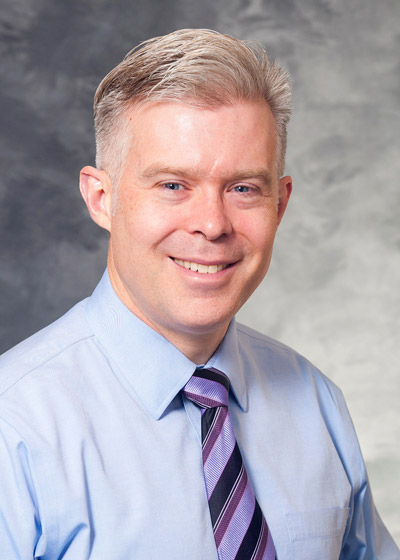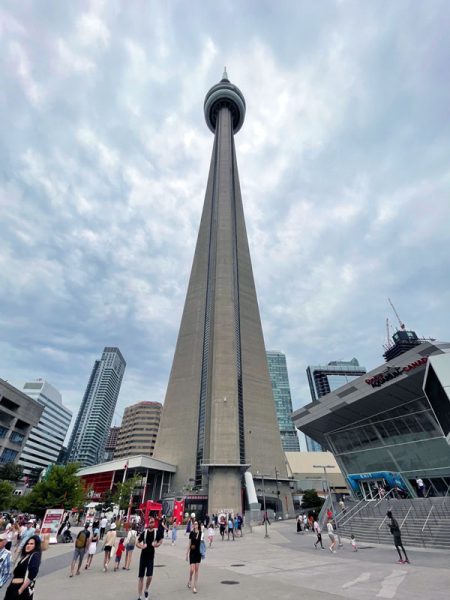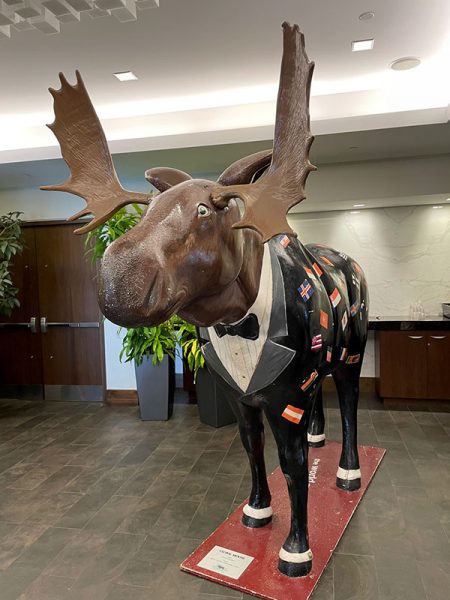Site Selection and Sustainability
Dear Friends and Colleagues,
I am energized after having recently returned from Toronto as part of planning for the ISMRM 2023 Annual Meeting. Niv Agarwal (2023 AMPC Chair), Brian Hargreaves (2024 AMPC Chair), Roberta Kravitz (Executive Director), and Anne-Marie Kahrovic (Associate Executive Director) and I visited the Toronto Convention Center and other important sites relevant to the Annual Meeting next June. It was a productive visit and I’d like to extend my thanks and compliments to Destination Toronto who were outstanding hosts, and who have been great partners in our preparation for Toronto 2023.
Can you believe that 2023 will be our fourth annual meeting in Toronto? I still remember well the past three meetings including 2003, 2008, and most recently 2015. The convention center has been refurbished and the surrounding area continues to develop and thrive with new hotels and nearby activities such as the CN Tower, Hockey Hall of Fame, and old town Toronto including the St. Lawrence Market, and much more. We even enjoyed an authentic peameal bacon sandwich with a real Canada Dry ginger ale – very Canadian!
Our visit brought back great memories for me including terrific meetings at different stages of my career including 2003 (radiology resident), 2008 (Assistant Professor), and 2015 (Professor). It also reminded me of the the first pandemic in my living memory, with the original SARS outbreak that led to postponement of the 2003 meeting from May until July of the same year. It was no small feat to reschedule the 2003 meeting and it is testament to the amazing efforts of the ISMRM Central Office and our highly collaborative relationship with Toronto Convention Center and Destination Toronto. The value of these relationships, which continues to thrive with Toronto as a result of the original SARS experience, cannot be understated when planning Annual Meetings.
This last point raises an important topic: How does the ISMRM select sites for our Annual Meeting? The answer to this question is surprisingly complex, nuanced, and multifactorial, and I’d like to dedicate the rest of this blog to address this question, including the urgency of incorporating sustainability into this process.
Site selection for the Annual Meeting begins 4-5 years prior to an Annual Meeting. Competition for viable conference centers appropriate in size and configuration is intense because there are a limited number of centers and cities around the world that can meet our multi-faceted needs. For instance, given the length of our meeting, we need to book our meetings well in advance to ensure we have all the space we need. And, of course, we do everything we can to ensure we do not overlap with other key association meetings in our field.
The Central Office starts the process with a request for proposal (RFP) going out to pre-qualified cities within the region targeted in our four-year rotation. Once bids are received, the Central Office carefully reviews them based on a number of important criteria, narrowing the field of candidate cities to three or four. Site visits are conducted to confirm key aspects of the bids and to negotiate preliminary contract terms. A final vetting is then performed by the Central Office, narrowing the selection to two or three bids. A detailed review is then submitted to the Board of Trustees, which makes the final selection.
Multiple important considerations are made as part of these deliberations, including:
- Strategic locations from regions around the world that reflect the international character of our society, including North America with ~50% of our membership, Europe with ~30% of our membership and other regions of the world including Asia, Oceania, Africa and South America with ~20% of our membership. Based on membership demographics, the location of the Annual Meeting is on a four-year cycle: North America (east-central, eg. Toronto), Europe (eg. London), North America (west-central eg. Vancouver), and a fourth region, typically Asia (eg. Singapore).
- Viability of the convention center to meet the size and needs of our Annual Meeting is essential, with high quality facilities necessary to accommodate our scientific and educational programs, committee meetings, and technical exhibits.
- Affordability. There is tremendous variability in the cost of convention centers, and value is a major consideration for site selection. While meetings in North America are generally the least expensive, we recognize the strategic importance of siting meetings in multiple regions of the world. Indeed, our best attended meetings are typically those in Europe. The cost of hotel accommodations and other expenses to attendees are also a major consideration.
- Access. The Annual Meeting site should be easily accessible, ideally a central hub requiring no more than two flights from most regions of the world. A city with attractions outside of the conference to support meeting activities and tourism is highly desirable.
- A strong working relationship with a city and its convention center pays major dividends to ensure a successful experience for our Annual Meeting attendees, and for negotiating favorable fees to maintain the lowest possible cost.
- Safety and Stability. The safety and wellbeing of our attendees is of paramount importance. Political and economic stability are essential, and other intangibles such as free speech and human rights are inevitably factored into the eventual site selection decision.
Climate change is an urgent, existential crisis facing the world, and the ISMRM must do its part to address this global crisis through effective sustainability efforts. Given that the Annual Meeting and workshops are the largest contributors to our Society’s carbon footprint, it makes sense that we start there. For this reason, the ISMRM leadership is actively working on a multi-pronged approach to reduce our carbon footprint.
Given that air travel is (by far) the leading contributor to the carbon footprint of the Annual Meeting, the ISMRM must consider sustainability as a major factor in site selection. Given the distribution of our membership around the world, the choice of Annual Meeting site has a dramatic impact on emitted carbon from air travel. This was described elegantly in an analysis by Böhm et al in abstract 4156 from the ISMRM 2020 meeting. In this beautifully presented analysis, the authors demonstrate large variations in the overall carbon footprint of the Annual Meeting by as much as three-fold, based on the air travel by attendees to various sites. Moving forward, the ISMRM will include the impact of site selection on our carbon footprint using a similar approach.
In addition to incorporating sustainability as a major factor that drives site selection, additional steps that are already underway include:
- A sustainability program was introduced by an ad hoc committee led by Christopher Hess, MD, PhD, in advance of the 2020 meeting in Sydney, Australia. As we pivoted to subsequent online meetings, this plan was shelved, but has been reinstituted in advance of the 2023 Toronto meeting. Details for the ISMRM sustainability program are posted on the web. I would encourage you to review what we have done, what we are doing and what we are planning to do. We have identified important ways you can participate in efforts to reduce your ISMRM-related carbon footprint.
- Carbon Offsets. At the London meeting, I requested and the Board approved, ongoing funding to pay for carbon offsets for all essential ISMRM related travel by staff, Board members as well as the Annual Meeting Program Committee. These carbon offsets were applied to offset travel to the site visit to Toronto as will all future ISMRM related travel by ISMRM staff and leadership.
- Hybrid Annual Meeting. There is a clear need to continue to provide options for members to attend the Annual Meeting online in addition to the in-person meeting, ie: hybrid. Not only will online attendance improve inclusivity for those members unable to attend otherwise, but it will also provide an opportunity for members to reduce their carbon footprint by avoiding air travel to the Annual Meeting. As you know, the ISMRM recently completed a survey related to the hybrid meeting in London. Once the data are tabulated and analyzed, we will share these results with the membership and use them to refine online options for the Toronto meeting. Other considerations that will guide the detailed implementation of on-line component will include cost and its impact on registration fees. Please see future blogs from Niv Agarwal and myself on this important topic, as details are developed and finalized.
- Baseline carbon footprint. Measuring a problem is the first step towards addressing it. To that end, developing ISMRM-specific carbon footprint metrics will be the first step to determine the overall scope of the ISMRM carbon footprint and to identify opportunities to reduce carbon emissions. I have consulted with the Nelson Institute, an internationally recognized climate institute and will work with the ISMRM Central Office and other members of the society to develop metrics aimed at measuring the baseline carbon footprint of ISMRM related activities including the Annual Meeting and workshops. Using baseline measurements, we aim to identify opportunities and next steps to further reduce carbon emissions. Not only are these efforts mission critical to the society but they are the existential issue of our times. It is essential that we do our part and work towards these important goals.
There is a lot that goes into putting on a major international meeting, and selecting a site is just the beginning. As we move forward it will be essential that we make sustainability efforts aimed at mitigating carbon emissions central to all of our major activities. We have momentum and talent on our side, and while I believe the above efforts are a good start at addressing sustainability, there is much more work to do.
As I come down from the high of our visit to Toronto and reflect how much the world has changed in the last 20 years since the 2003 meeting, despite the many challenges humanity faces, I can’t help but maintain a strong sense of optimism for the future. While I know many challenges lie ahead, I know we can address them together, as we have done successfully in the past.
Sincerely,
Scott B. Reeder, MD, PhD, FISMRM
2022-2023 ISMRM President

Peameal bacon sandwiches and Canada Dry Ginger Ale with friends – now we’re talking!

Peameal bacon sandwich, St. Lawrence Market









It’s very interesting to hear more about how sites for the annual conference are chosen, so thank you for giving us a glimpse into that process! I hope that members will continue to be kept involved and informed on aspects of sustainability at the ISMRM. On that note, the web page https://www.ismrm.org/sustainability/ is password protected and I am unable to access it. Will it be made public soon?
Sorry about that! The password has been removed.
Thank you!
Comments are closed.